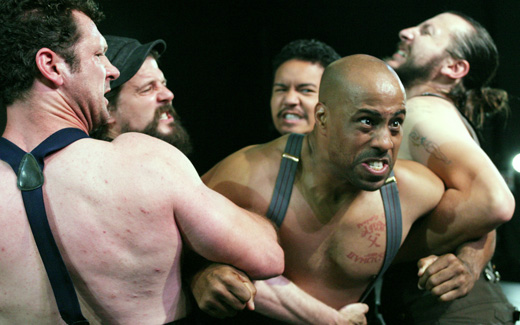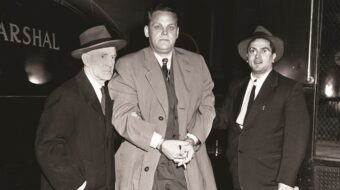
LOS ANGELES — Eugene O’Neill’s The Hairy Ape (1922) is a product of the short-lived post-World War I Expressionist school, which featured exaggerated characters, writ in bold strokes, often with harsh, mordant commentary on the kinds of gory horrors the world had just witnessed on the battlefields of civilized Europe, and lit up with bright spotlights at rakish angles to point up the deep shadow side of a distorted humanity. Both German and Soviet theater of that period were especially creative in this mode, and other playwrights and directors quickly picked up the style.
O’Neill’s first play was produced in 1916, after he had fallen in with the Provincetown Players and radical journalist John Reed. By 1922 he had already won two Pulitzer Prizes – for Beyond the Horizon in 1920 and Anna Christie in 1922. He would later win two more, plus the Nobel Prize for Literature in 1936. O’Neill’s next work after The Hairy Ape was Desire Under the Elms (1924), a decidedly non-Expressionist family drama whose plot traces back to Greek tragedy and to Swedish playwright August Strindberg.
The Hairy Ape is a stark broadside against the vast differential of wealth and power of “The Roaring Twenties.” Excess consumption and privilege on the part of the few; degradation, humiliation and brutalization for the many toiling away in the engine rooms of capitalism. The protagonist Yank is the most class-conscious of his peers, fellow coal shovelers in the boiler room of a fancy ocean liner steaming toward Southampton, England. The sniveling do-gooder daughter of the ship owner is onboard and curious to see “how the other half lives.” When she descends into the engine room, dressed like an angel in her pure white gown suitable for an elegant garden party, and when she hears Yank’s brutal, frank, vulgar speech, she is appalled at his bestiality. Yank is driven insane with a frightening class rage that he cannot control. O’Neill endows this terrifying character “with a fierce elegiac poetry,” in the words of the brilliant director Steven Berkoff. The seaman “represents all too powerfully and even poignantly the heart of the workingman” whose soul has never been touched by love.
The great African American actor Paul Robeson was identified with O’Neill’s work in three different works: All God’s Chillun Got Wings and The Emperor Jones (both 1924), and The Hairy Ape, of which he was able to give only five performances in London in 1931 before he quit out of pure exhaustion. Although Robeson was generally well received as Yank, the play received sharp barbs owing to the producers’ “racially blind” casting in the part. One London critic wrote that “It upsets the balance or alters the whole direction of the piece…. One cannot help thinking that here is something which has to do with racial consciousness and the oppression of the [N]egro.”
This issue, so remarked upon today, was also controversial then, but audiences have come “a long day’s journey” since 1931: We can now appreciate not so much the contradiction of the author’s original intent but rather the additional layering provided by unexpected casting.
That is indeed the case with the present production at the Odyssey, whose lead is taken by the virile, muscled Hailé (pronounced hi-lei) D’Alan, born on Chicago’s South Side and now mostly resident in Austin, Texas. It should be noted that D’Alan is the only non-white member of the cast, so presumably the racial angle is intended in these Black Lives Matter times. However, his understudy Jeremiah O’Brian, another cast member who may have occasion to jump into Yank’s role at some point, is white.
A “message” play delivered by thunderbolt
D’Alan is a phenomenon of nature in this role. It barely matters that in the early shipboard scenes with his seven heavily imbibing fellow coal stokers the language is shouted so gruffly and drunkenly that we barely understand a word. It’s clearly meant to sound only intermittently human from a gang of virtual galley slaves, who indeed are seen knuckle-dragging in their simian-like gait. Yet Yank is a worker proud to “breathe and swallow coal dust.” His awareness of class screams out of his guts. By contrast, the character of the old salt Paddy (Dennis Gersten) has memories of the old tall ships of decades past, when a sailor could enjoy the elements, hone his seamanship skills, and not be condemned to spending his voyages down in a hellish oven.
The crew move as one with the heaving and swelling of the waves. I almost regretted I hadn’t taken a Dramamine before I sat down, so realistic did Berkoff make the impression of the movements of a great ship at sea. The other cast members compete with one another in exuding testosterone from every pore, but are less distinguishable as individual characters.
The two ladies on board, the heiress Mildred (Katy Davis) and her chaperone Aunt (Jennifer Taub) play their snooty parts to the hilt. There’s little question where O’Neill’s sympathies lay when he poured his heart into this tirade against the rich. This is a “message” play delivered by thunderbolt.
When the ship lands back in New York (from his accent this appears to be Yank’s home town) the whole cast except for Yank and his sidekick turn into suave boulevardiers just leaving church services, looking like they danced out of a satirical George Grosz etching. They eventually call the cops on Yank for taunting and assaulting them. Yank turns to the Industrial Workers of the World (IWW), which he’s heard about as defenders of his class, thinking at last he has found the place where he can belong. But even they cast him out as “a brainless ape,” believing that either he’s too stupid for them or that his talk of violence and dynamite can only be that of a paid provocateur.
Berkoff directs his ensemble as if it’s ballet, every movement calibrated to connect organically with the other actors on stage. It’s a brash, surreal montage of speech, pantomime, and tableau. The set design is by Christopher Scott Murillo, lighting by Katelan Braymer, and sound design by Christopher Moscatiello. The live percussionist in this loud, powerful production is Will Mahood. Its 85 minutes, with one intermission, deliver a proletarian punch to the solar plexus that a viewer will feel long after the curtain calls.
In its recapitulation of the mind-numbing, soul-crushing repetitive motions endemic to industrial work, the 1922 Hairy Ape anticipates Elmer Rice’s play The Adding Machine by one year, and the Charlie Chaplin film Modern Times by a full 14 years. It would be difficult to overstate the importance of the historic precedent O’Neill established. The play attracted the attention of the new Federal Bureau of Investigation, which kept a file on O’Neill. The FBI’s report on him stated that “The Hairy Ape could easily lend itself to radical propaganda, and it is somewhat surprising that it has not already been used for this purpose.” The mayor of New York tried to shut down the production for fear it would provoke labor disputes or riots.
But the Twenties were a hard time for labor in America. The anarcho-syndicalist IWW was by then largely routed, victim of the Palmer Raids and anti-immigrant fervor across the land, and the new Communist Party, inspired by events in Bolshevik Russia, had just recently been established. The national mood was caught up in the heady prosperity of speculation which ended, as we all know, with the crash of the stock market in 1929.
American Expressionism is not the most beloved period of our national theater tradition, as witnessed by the relative infrequency of stagings of this play. So now I have a mea culpa to offer: Because honestly I was not familiar with The Hairy Ape, in my 1989 biography of the composer Marc Blitzstein, I failed to note that it had to have been a strong influence on his 1937 musical The Cradle Will Rock, especially in its cartoonish portrayal of the ruling-class Liberty Committee and of the Reverend Salvation, who preaches pacifism when it’s personally convenient, and war when he’s properly compensated.
The Odyssey production utterly convinces that The Hairy Ape is one of the early masterworks of 20th-century American theatre. The ending is chillingly cathartic. Yet it is no period piece staged for our academic edification. It reveals truths about our society that are still very much on point. Do not miss it.
Performances run through July 17 on selected Wednesdays and Thursdays in May and June, Fridays and Saturdays at 8 pm, and Sundays at 2 pm. For exact schedule and for tickets and information, contact the Odyssey at (310) 477-2055 ext. 2, or www.OdysseyTheatre.com. The Odyssey Theatre also has a Facebook page. Three performances have been designated as $10 ticket nights: May 20, June 2, and July 1. The theatre is located at 2055 S. Sepulveda Blvd., Los Angeles 90025.
Photo: (left to right) Jeremiah O’Brian, Joseph Gilbert, Andres Paul Ramacho, Hailé D’Alan, Anthony Rutowicz / Photo by Enci Box












Comments